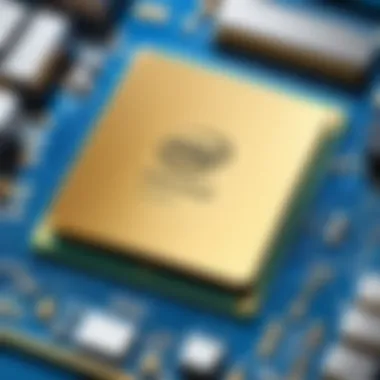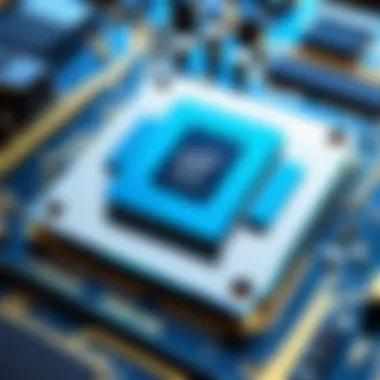Exploring the Latest Intel Chipset Advancements


Intro
In the ever-evolving landscape of information technology, the advancements in Intel chipsets stand out as pivotal developments. These chipsets shape not only the hardware realm but also the frameworks within which various software technologies thrive. Understanding them is key for anyone working in software development, cloud computing, or data analytics. They serve as the backbone of modern computing systems, influencing how efficiently applications run and manage data.
But what exactly do we mean by ‘Intel chipsets’? Essentially, they are the communication centers of computers, facilitating the interaction between the CPU, memory, storage, and peripheral devices. As we peel back the layers of the most recent innovations presented by Intel, it becomes increasingly clear that the implications of these advancements reach far beyond mere computing efficiency.
Let's embark on this journey, examining the essence of the latest Intel chipsets, and see how they affect not just machines and performance but also broader software applications and technologies.
Prologue to Intel Chipsets
Understanding Intel chipsets is crucial for anyone looking to grasp the fundamentals of modern computing. These chipsets are the unseen yet invaluable components enabling communication between the CPU and other hardware devices. They not only influence performance but also dictate the specific features your system can support. In this article, we delve into the latest enhancements in these chipsets, emphasizing their functionality and significance.
Overview of Intel as a Company
Intel has carved its niche as a titan in the tech industry, synonymous with innovation and quality. Founded in 1968, the company has driven many advancements in microprocessor technology, making it a household name in computing. With its eyes firmly set on the future, Intel continuously breaks new ground, reflecting the evolution of technology itself.
Whether it’s developing new architectures or refining existing ones, Intel remains at the forefront due to its commitment to research and development. This focus enables Intel to adapt to changing market dynamics and customer needs, a trait that helps maintain its competitive edge.
The Role of Chipsets in Computing
Chipsets are a vital piece of the computing puzzle. They serve as the backbone of your computer, facilitating communication among various components. It could be said that chipsets are akin to traffic controllers, ensuring that data moves smoothly between the processor, memory, and I/O devices. Without an optimal chipset, overall performance can be akin to driving with a flat tire—you might still be able to get from point A to B, but it won’t be a pleasant ride.
Moreover, the integration of advanced features in chipsets can greatly affect performance metrics and capabilities. For instance, support for the latest PCIe standards can enhance data transfer speeds, which is particularly critical for data-heavy applications used in fields like gaming and artificial intelligence. As tech professionals and enthusiasts alike can attest, understanding chipset technology is essential for harnessing the full potential of modern computing.
Latest Intel Chipset Models
The realm of computing is continually evolving, and at the heart of this transformation are chipsets. They're the unsung heroes behind various computing devices, ensuring every piece functions harmoniously. Understanding the latest Intel chipset models is crucial for professionals in fields like software development, data analysis, and IT.
Preamble to the Newest Releases
Intel's latest chipset releases mark significant steps forward in performance and efficiency. The move from older generation chipsets to the newest models can feel like stepping from a child’s tricycle to a high-speed motorcycle. What sets these new models apart lies in how they integrate better with current technologies and trends.
For instance, the Intel Z790 and H770 chipsets not only support the latest processors but also enhance graphics performance, making them advantageous for gamers and creators alike. This is because these models introduce support for faster memory and enhanced bandwidth capabilities, which are critical for demanding applications.
Moreover, increased compatibility with PCIe 5.0 allows for much greater data throughput between hardware components. This is particularly important for those relying on rapid data processing, like data scientists and cloud computing professionals. Keeping abreast of these developments means being strategically positioned in the tech industry.
Key Specifications of Current Models
When examining the current Intel chipset lineup, several standout specifications catch the eye:
- Enhanced Memory Support: Most new chipsets support DDR5 memory, providing better speed and bandwidth.
- PCIe 5.0 Compatibility: This allows for double the data transfer rates compared to its predecessor, PCIe 4.0, which is impactful for high-performance graphics cards and NVMe SSDs.
- Integrated Thunderbolt™ Technology: This feature enables faster data transfer between devices and is crucial for users who need high-speed connectivity.
- Increased USB Ports: The availability of multiple high-speed USB ports in new models simplifies connectivity for peripheral devices such as keyboards, mice, and external drives.
"Understanding these specifications helps professionals make informed decisions about upgrades or purchases, ensuring they meet their specific needs effectively."
Furthermore, support for Wi-Fi 6E in many of these chipsets adds another layer of future-proofing. This standard facilitates faster wireless connections with less congestion, catering to environments where multiple devices are connected simultaneously.
In summary, the latest Intel chipset models encapsulate remarkable improvements that cater to the evolving demands of technology users, fostering innovation across various domains. Keeping an eye on these models can empower tech professionals to stay ahead in a fiercely competitive landscape.
Architecture and Design
The significance of architecture and design in the context of Intel chipsets can't be overstated. These elements play a critical role not only in determining performance levels but also in how well a chipset integrates with different systems. A well-crafted architecture leads to efficient data processing, which translates into swift actions and improved responsiveness of the overall computing system. Major considerations include heat management, connectivity options, and power consumption that ultimately dictate the chipset's operational efficiency.
Chipset Architecture Breakdown


Understanding the chipset architecture is like peering under the hood of a performance car. The architecture comprises various layers that work in harmony. At its core, you'll find the CPU interface which connects the processor to the chipset, facilitating data transmission at lightning speed. Sitting alongside are input/output (I/O) controllers that manage all external device communications. For example, the Thunderbolt 4 technology significantly boosts data transfer rates and enables more devices to connect seamlessly. This intricate relationship between different components ensures that everything runs smoothly, which is especially beneficial for high-demand applications.
"The advancements in architecture lead not only to improved speeds but also to increased capabilities, able to handle demanding applications that were previously unachievable."
Furthermore, the architecture is built around flexibility. Many chipsets support multiple configurations, allowing users to choose what fits their specific needs best. This adaptability means whether you're running a simple office application or managing a massive cloud computing environment, the chipset can factor into performance accordingly.
Innovative Design Features
As we venture into the innovative design features of the latest Intel chipsets, it's clear that they are not merely about raw performance; they are handsomely crafted for today’s multifaceted computing requirements. One notable characteristic is integrated graphics which allow for enhanced visuals without needing a separate graphics card. This is critical for devices aiming for thinner designs and lighter weights.
Another interesting aspect is the integration of AI capabilities right into the chipset. This trend signifies a shift towards smarter computing, where tasks can adapt in real-time based on the user's behavior. For IT professionals and developers, designing applications that leverage these features opens up a whole new world of possibilities.
Additionally, energy efficiency measures are becoming paramount. The incorporation of low-power states in chipset designs reduces the overall carbon footprint while ensuring devices remain responsive:
- Dynamic power management allows chipsets to adjust performance according to workload.
- Multi-core processors distribute tasks effectively, ensuring better overall power utilization without sacrificing speed.
In essence, Intel’s approach to architecture and design reflects a horizon where capability meets sustainability, providing both raw power and the finesse required for modern computing challenges.
Performance Analysis
Performance analysis remains a cornerstone when it comes to evaluating any chipset, including Intel's latest entries. Understanding how these chipsets perform in real-world scenarios can help developers, IT professionals, and tech enthusiasts make informed decisions when purchasing or building systems. It doesn't just boil down to raw power; one must consider factors like thermal management, energy efficiency, and support for emerging technologies.
A thorough performance analysis reveals the potential bottlenecks in a computing system, identifies how well new hardware integrates with older components, and sheds light on how Intel’s innovations adapt to evolving software demands. For instance, modern applications require high-throughput and low-latency interactions, often making performance metrics the decisive factor for users.
Benchmarking the Latest Models
To gauge the competency of the latest Intel chipsets, benchmarking serves as a vital tool. Various metrics are scrutinized, such as multi-threaded performance, single-core efficiency, and power draw under heavy workloads.
For example, in a recent benchmarking session involving the Intel Core i9-13900K, various tests were conducted, evaluating gaming outputs alongside computational tasks. The outcomes suggested:
- Single-core performance: Outshined many competitors, making it ideal for gaming.
- Multi-core efficiency: Supported multitasking with ease, suitable for content creation.
- Thermals: Kept within reasonable limits, thanks to Intel's advanced thermal management solutions.
Such evaluations illuminate how Intel’s latest offerings hold up against the rigors of modern tasks, shedding light on how these models can benefit specific user needs.
Comparison with Previous Generations
Looking back provides context to the evolution of Intel chipsets. For instance, when comparing the current Intel models against their predecessors like the Core i7-11700K, several notable improvements come to the fore.
- Clock Speed: While the Core i7-11700K reached a max boost of 5.0 GHz, the i9-13900K often breaks that barrier, pushing performance limits further.
- Power Consumption: Earlier generations drew more power for tasks that the latest models handle more efficiently, showcasing an improvement in energy management.
- Integrated Graphics: Recent models include better integrated graphics. This means gamers or lighter users might avoid dedicated GPUs without compromising performance.
Considering these metrics provides a clearer view of Intel's direction. The enhancements made across generations not only address current market demands but prepare the system for upcoming software and technology trends.
Compatibility and Ecosystem
The compatibility of Intel chipsets with various components and devices is pivotal in determining their effectiveness in real-world applications. A chipset doesn't operate in isolation; it interacts with motherboards, CPUs, and other peripherals, making an understanding of this ecosystem essential. With the rapid advancements in technology, ensuring seamless compatibility has become a cornerstone of modern computing. This section explores critical elements of compatibility and how they enhance system performance, aimed at software developers, IT professionals, data scientists, and tech enthusiasts.
Motherboard Compatibility
When speaking of Intel chipsets, motherboard compatibility is a prime concern. Each chipset supports specific motherboard designs and form factors. For instance, the latest Intel Z790 chipset is designed to work exclusively with motherboards based on the LGA 1700 socket. This means that trying to pair it with older sockets, like LGA 1200, would result in a no-go situation.
Consider this: you’ve just invested in the latest Intel chipset, but to your dismay, you discover it won’t fit on your aging motherboard. This can be a costly oversight. The benefits of ensuring compatibility include:
- Optimal Performance: Ensuring the chipset and motherboard work well together maximizes performance and stability.
- Future-proofing: Selecting a motherboard that supports the latest chipset allows for upgrades without needing to replace multiple components.
- Feature Access: Some advanced features, like overclocking or enhanced memory support, require specific motherboard designs to function effectively.
In light of these points, it’s clear the initial choice of motherboard greatly impacts the capabilities of the entire system. Always check manufacturer specifications before making decisions.


Impact on Peripheral Devices
The influence of Intel chipsets extends beyond just internal components; they also determine how well the system interacts with external peripherals. High-performance gaming rigs or data analytics workstations rely heavily on seamless communication with devices such as graphics cards, storage options, and input devices.
A chipset like the Intel B760 has specific USB controller support. This directly affects the number of ports and their data transfer capabilities. Here are key considerations regarding peripheral compatibility:
- Connection Standards: New chipsets generally support higher standards, such as USB 3.2 or Thunderbolt, which allow faster data transfer and better utilization of connected devices.
- Power Management: Efficient power distribution from the chipset ensures peripherals receive adequate power for operation without causing system instability.
- Driver Support: Chipsets often come with specific drivers that maximize compatibility and functionality of peripherals, ensuring they work as intended with the operating system.
Investing the time to understand these compatibility issues can yield significant benefits, from improved performance to stability. The underlying connections foster an ecosystem where all parts work together harmoniously, driving the intended applications with the necessary speed and reliability.
"Motherboard and peripheral compatibility aren’t just a checkbox on the list; they are vital for achieving a balance that reflects the full potential of the Intel chipset architecture."
In sum, compatibility and ecosystem considerations are crucial. They dictate the synergy between the chipset and its companions, guiding the decisions tech professionals and enthusiasts must make when crafting their systems. Understanding these relationships ensures a streamlined experience, enhancing overall computing efficiency.
Use Cases and Applications
Understanding how the latest Intel chipsets are utilized across various domains is fundamental to grasping their full potential. These chipsets are more than just components; they are pivotal in shaping the way systems function in diverse scenarios. Knowing the use cases and applications not only highlights the significance of the technology but also underscores the benefits they bring to different sectors. With every new release of Intel chipsets, there are enhancements that cater specifically to the needs of users, whether they are gamers, data scientists, or software developers.
Applications in Gaming
Gaming is a sector that consistently pushes the envelope for hardware capabilities. The latest Intel chipsets, like the Intel 13th-gen Core series, have been designed to fully exploit advancements in graphics technology and processing power. High frame rates, low latency, and multi-threading support ensure smoother gaming experiences and better NPC interactions. Features such as Enhanced Intel SpeedStep technology and Intel Turbo Boost help dynamically adjust performance according to the game’s intensity.
Here are some specifics on how Intel chipsets enhance gaming:
- Visual Quality: Support for high resolutions and advanced graphical features contribute to richer environments.
- Real-time Ray Tracing: This technology allows for more realistic light and shadow effects, enhancing immersion.
- Multiplayer Performance: Low latency communication facilitated by advanced chipset designs significantly boosts multiplayer interaction.
- Streaming Capabilities: Gamers often stream their gameplay; thus, chipsets that offer great performance for both gaming and streaming services are crucial.
"With the right chipset, gaming isn't just about winning; it's about living in an unforgettable digital world."
Implications for Data Centers
Data centers represent another critical arena where the latest Intel chipsets demonstrate their prowess. Organizations are continually searching for ways to optimize their server environments and increase energy efficiency while maximizing processing capabilities. The shift toward cloud-based services necessitates performance that can handle large-scale data operations seamlessly.
Intel chipsets tailored for data centers provide several advantages:
- Enhanced Performance: Increased core counts and hyper-threading capabilities allow for better handling of concurrent tasks.
- Energy Efficiency: Modern chipsets have power-saving features that help reduce operational costs, which is a significant consideration for large data centers.
- Scalability: Chipsets like the Intel Xeon series are designed to be scalable, making them suitable for a variety of data loads and applications.
- Security Features: Integrated security options protect sensitive data, making them essential in an environment where data breaches can occur.
These benefits illustrate why Intel chipsets remain the backbone of many data centers worldwide.
Software Development Synergies
For software developers, having a robust chipset can mean the difference between swift coding and frustrating delays. Development environments often demand high computational power, especially when compiling large projects or running complex simulations. Intel chipsets provide the horsepower necessary to handle such demands without breaking a sweat.
Consider some pivotal aspects of how chipsets affect software development:
- Version Control and Collaboration: Faster processing aids in merging code efficiently, helping teams work better together.
- Development Tools Compatibility: Many popular IDEs (Integrated Development Environments) optimize functions specifically for Intel architectures, boosting overall productivity.
- Virtualization: Chipsets with advanced virtualization support enable easier development and testing of software across multiple platforms.
- Increased Productivity: Features such as Intel Hyper-Threading and improved cache management ensure that development tasks are completed in less time.
By leveraging these applications, both individual developers and large teams significantly enhance their workflows. The cutting-edge advancements in Intel chipsets provide tools that not only meet but exceed the expectations of the tech industry.
Future Trends in Chipset Development
The realm of chipset development is rapidly evolving, and keeping a keen eye on future trends is essential for all stakeholders involved in technology, from software developers to IT professionals. The landscape of computing continues to shift, driven by an insatiable demand for performance and efficiency. This section aims to shine a light on what lies ahead in the world of Intel chipsets, exploring predictions and technological innovations that will shape this domain.
Predictions for Upcoming Releases


With the relentless pace of innovation, detecting even the slightest shifts in technology can be a daunting task. However, a few trends have begun to crystallize based on current development trajectories.
- AI and Machine Learning Integration: We might see chipsets designed specifically to optimize AI workloads. The incorporation of specialized cores to cater to machine learning tasks could lead to significant performance gains in data-intensive applications.
- Sustainability and Energy Efficiency: As climate consciousness grows, Intel could focus more on producing eco-friendly chipsets. Future models may utilize materials and designs that minimize energy consumption, without sacrificing performance.
- Enhanced Connectivity: Expect improvements in connectivity standards, such as faster PCIe interfaces and more robust support for wireless technologies like Wi-Fi 6E and beyond. This will be crucial for applications demanding high-speed data transfer.
- Modular Chipsets: A gradual shift towards modular designs seems likely. This approach allows users to upgrade individual components without replacing the whole system, catering to both personal and enterprise needs.
"Adaptability will be the hallmark of the next generation of Intel chipsets, allowing users to configure their systems based on specific requirements."
Technological Innovations on the Horizon
As we peer further into the future, several technological innovations are poised to redefine chipset capabilities. Here are some noteworthy advancements:
- 3D Chip Stacking: Technology that allows chips to be stacked vertically is gaining traction. This could condense chipsets into smaller footprints while improving performance and reducing latency.
- Quantum Computing Readiness: This may seem far off, but preparing chipsets to support quantum operations is a conceivable trend. While still in its infancy, initial integration into consumer technology could change the paradigm of computing entirely.
- Increased Use of FPGAs: Field-Programmable Gate Arrays could become commonplace in chipsets, allowing for greater customization and adaptability in processing tasks unique to various applications.
- Advanced Security Features: With cyber threats becoming more sophisticated, future chipsets may feature advanced built-in security protocols to safeguard systems from attacks.
In summary, predicting chipset trends involves a bit of speculation guided by current technological imperatives. The next generation of Intel chipsets is likely to be marked by enhanced performance capabilities, sustainability, and increased flexibility, keeping pace with the ever-demanding tech landscape.
The Competitive Landscape
In the fast-evolving world of technology, understanding the competitive landscape of Intel chipsets is critical. This segment highlights the various players in the chipset arena, examining how Intel positions itself in the market and the implications for tech professionals seeking to optimize their hardware solutions. The competitive landscape not only informs manufacturers and developers about trends and innovations but also provides insights that can lead to more informed purchasing decisions. With constant advancements in performance and features, being aware of competitors allows Intel to adapt and improve their offerings effectively.
Key Competitors in the Chipset Market
Several notable companies compete with Intel in the chipset market. These competitors include:
- AMD: A significant rival, AMD has made a mark with its Ryzen series, targeting gamers and professionals with high-performance requirements. Their chipsets often provide a competitive edge in multi-threaded tasks.
- Qualcomm: Focusing mainly on mobile and IoT devices, Qualcomm offers a different perspective with its ARM-based chipsets, favoring energy efficiency alongside performance.
- NVIDIA: Known predominantly for graphics processing units, NVIDIA has been venturing into the chipset space, particularly with developments related to artificial intelligence and machine learning applications.
- Apple: With its custom silicon, Apple has disrupted traditional norms, creating a closed ecosystem that optimized performance, especially in their latest Mac computers.
These companies are not just competing in raw power but also in specialized applications, making it imperative to analyze their market strategies.
Market Positioning of Intel Models
Intel's market positioning is both a strength and a challenge. The company has historically dominated the x86 architecture, which dominates personal and enterprise computing environments. Presently, Intel is”
"battling to reclaim its leadership position in a market increasingly crowded by competitors offering innovative products that challenge Intel's legacy.”
Key elements of Intel's market strategy include:
- Innovation Commitment: Intel continually invests in research and development, ensuring that they remain at the forefront of technology.
- Diverse Product Range: Their chipsets cater to various markets, from mobile devices to powerful enterprise solutions.
- Ecosystem Development: Partnerships with motherboard manufacturers and software developers ensure that Intel chipsets integrate smoothly with a wide array of applications.
Despite facing fierce competition, Intel's investments into next-gen technologies—such as 5G and AI-capable architectures—mark its determination to not just participate in, but lead, the ongoing technological revolution.
Epilogue
In the rapidly evolving landscape of technology, recognizing the role of Intel chipsets is crucial for any software developer, IT professional, or data scientist looking to stay ahead. This article has systematically examined aspects ranging from architecture to performance analyses.
Summarizing Key Insights
As we've uncovered, Intel chipsets represent a significant leap in computational power. The latest models bring enhancements that cater to varied use cases, including gaming, data center operations, and software development. Here are some key takeaways:
- Performance Metrics: The benchmarks indicate substantial upgrades in computational speed and efficiency across newer models compared to previous generations.
- Compatibility: Understanding motherboard compatibility is essential for leveraging the full potential of these chipsets.
- Emerging Applications: The dual focus on gaming and data-centric applications speaks to the adaptability of Intel technology in different domains.
Bear in mind that keeping abreast of these advancements is not just about specifications; it shapes how we utilize technology today and in the future.
Final Thoughts on Future Developments
The realm of chipsets is only going to grow more intricate and cutting-edge. With predictions swirling regarding upcoming releases, Intel faces pressure not only from competitors but also from the expectation of its user base.
It’s clear that technological innovations on the horizon will likely further refine performance and enable new functionalities. Here’s why it matters:
- Increased Efficiency: Future chipsets are expected to focus on energy efficiency, addressing environmental concerns while maintaining performance.
- AI Integration: We're likely to see chipsets that enhance AI applications, catering to the rising demand for machine learning and data analytics.
- Continued Adaptability: As industry needs evolve, Intel's chipsets will need to remain flexible to ensure relevancy in different sectors.
The takeaway is simple: staying informed will not only keep you relevant but also ensure that you'll be equipped to maximize the potential offered by these advancements.
As you navigate your professional journey, understanding these chipset developments can lead to more informed decisions and innovative approaches to technology utilization.



